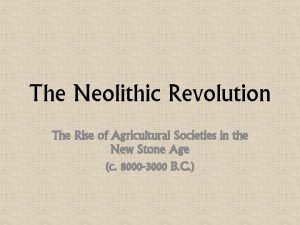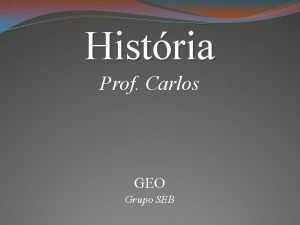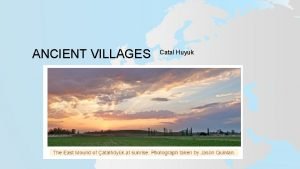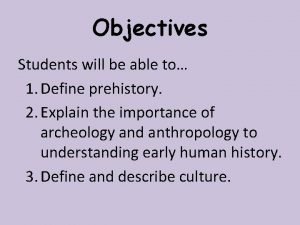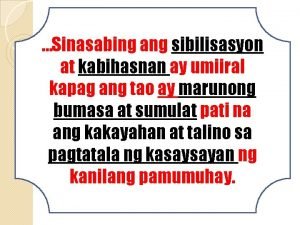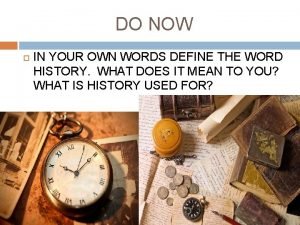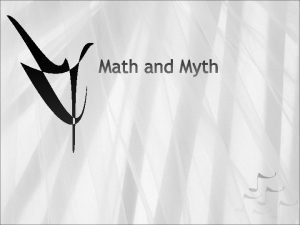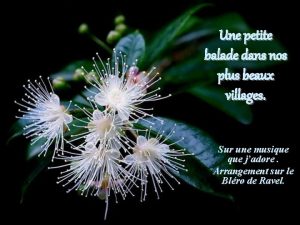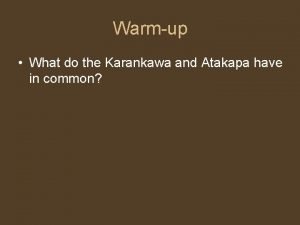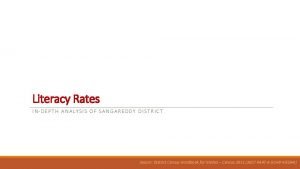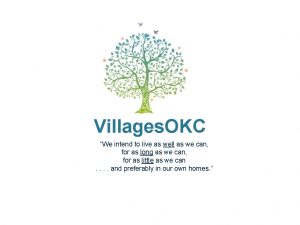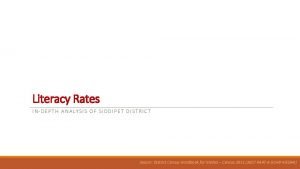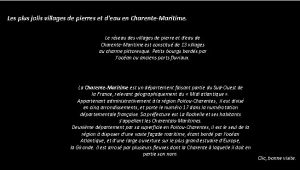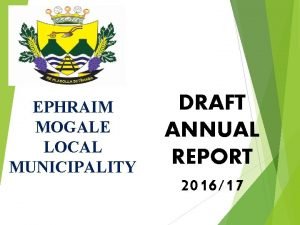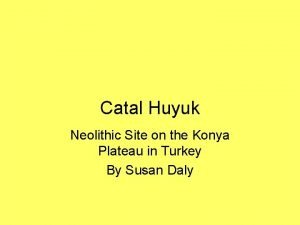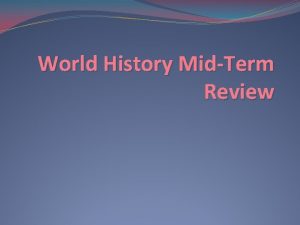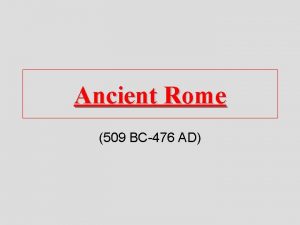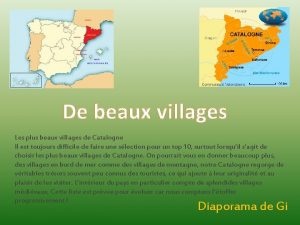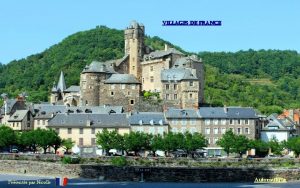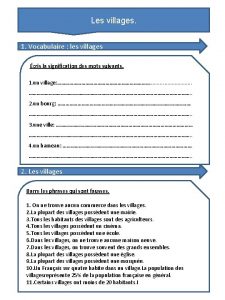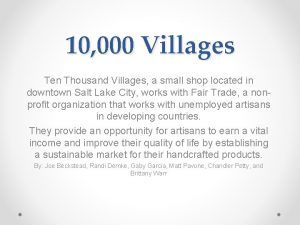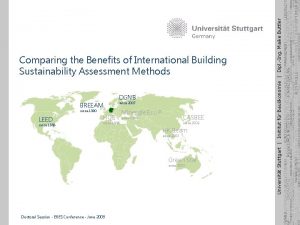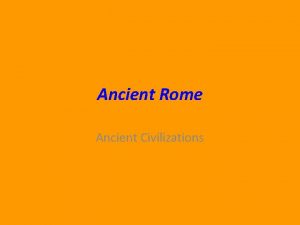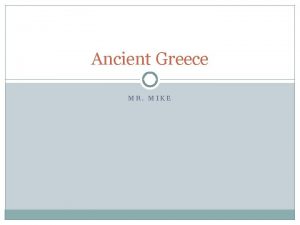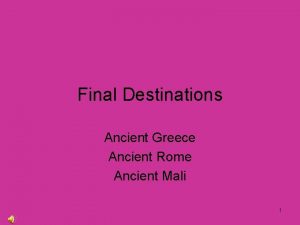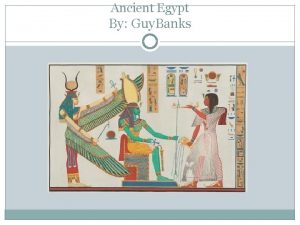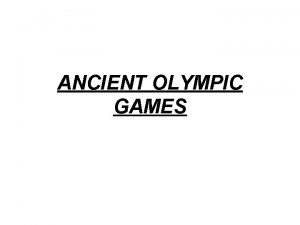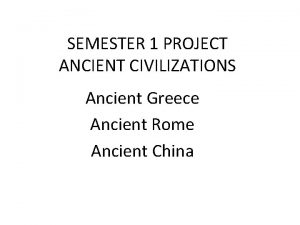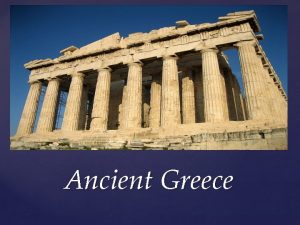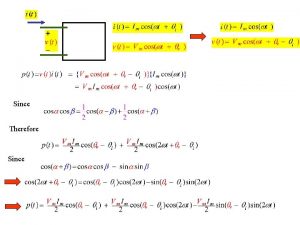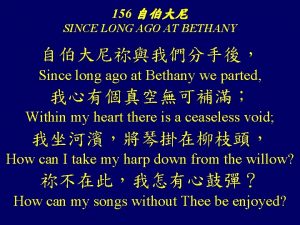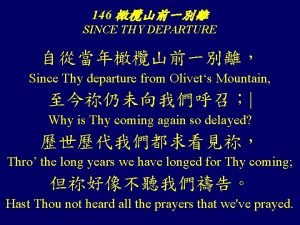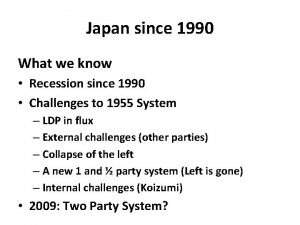ANCIENT VILLAGES Catal Huyuk CATAL HUYUK Since the






























- Slides: 30

ANCIENT VILLAGES Catal Huyuk


CATAL HUYUK • Since the 1960’s, excavations have uncovered a densely packed Neolithic settlement which dates back to 9000 years. (About 7, 400 BC) • Visible above the surface are only two mounds. • Underneath the surface is a complicated society.



RISE AND FALL OF THE NEOLITHIC TOWN • People first settled this area around 7, 400 BC • The area was a wetland, with the climate mostly moist and rainy. • Resources in the area included fish, water birds, and their eggs. • Toward the drier ground were agricultural fields, and herds of wild animals could be found roaming the plain. • By 6, 500 BC people were using cooking pots. • Domestic cattle and milk were introduced.



RISE AND FALL • There was an increase in housing and population density. • Burials and ritual behavior also became more complex. • People begin to decorate their homes and buildings. • Figurative art (of people) • At its peak, 3500 -8000 people lived, worked, and died here. • Later on, people started to spread out to other nearby areas, including West Mound • These people continued to bury their dead at East Mound.


ARCHITECTURE • People at Catal Huyuk continually built and rebuilt their houses. • Houses were somewhat rectangular, and closely built together with no streets in between. • People used the rooftops as streets. • They entered their homes using a wooden ladder through an opening in the celling. • The houses were different shape and sizes, but were about the same layout. • They has a center room with an oven below the ladder. • Domestic tasks were performed in this room, such as cooking. • Raised platforms within the rooms were used for sleeping and other domestic activities. • Beneath the platforms, they buried their dead. • Side rooms were accessed off the central room, providing storage.




HOUSING • People decorated their homes. • They used white plaster on the walls and floors. • Walls and floors had detailed paintings depicting hunting scenes and geometric patterns. • The walls were made of mud bricks. • Based on evidence from the site, it is believed that wet clay mixture was either placed directly on the wall between wooden boards or constructed using a mortar and sun-dried.


• Thick wooden posts were put up in the central room and may have been used to strengthen the structure. • It may can also created a division of living space. • People took good care of their houses, it took a lot of planning and forethought to build and maintain. • The houses were continuously under construction. They were burnt down and new homes were built above the old one. (Infilling) • This eventually created the mound that we can see on site today.

DAILY LIFE • Daily life took place within the settlement and without. • Men and women led very similar lives. • We know this based on analysis of human skeletons showing generally identical diets. • Infant mortality was high, as were the risks for women during childbirth. • Generally, people lived healthy and active lives. • The ate animal products such as fish, and beef and plants such as barley and wheat. • When someone died, people were buried under the floor of houses. • Bodies were tightly bound in a flexed position and place in a simple grave with few or no artifacts.


TOOLS & TRADE • People crafted obsidian and bone tools as well as ceramic materials. • Obsidian and bone were also used to create interest objects such as clay figurines and beads. • Many tools were also decorated. • People traveled to where obsidian was sourced from in Cappadoccia and Eastern Turkey • Traders even went as far as the Red Sea to obtain things such as baskets and shells. • People at Catal Huyuk valued artistry and decorations.

• Food, tools, and other resources were shared equally and used by all. • Ritual activities at Catal Huyuk revolved hunting, death, and animals. • Many people believe that the people believed in a mother goddess based on the discovery of many female figurines. • Recently, reinterpretations suggests that male and animal figurines were just as common, if not more so. • Equality appears to have been of primary important for these people.


WEST MOUND • It is believed that West Mound was occupied between 5, 900 -5, 600 BC. • Starting later than Catal Huyuk, but continued after the desertion of East Mound. • It is believed that the Carsamba River was once In the area between the mounds. • This time period is when we start to see painted pottery (Early Chalcolithic) • It is not clear why people established West Mound. • One theory suggests that the river changed its course and people moved to be closer to the water. • There is no evidence of burials under the houses, wall paintings, or infilling of abandoned houses.


• Pottery changed with the emergence of beautifully decorated pots. • A theory suggests this could be for entertaining guests with impressively painted serving vessels. • Cattle was consumed less, and decorations no longer depicted bulls or horns.





 Catal huyuk
Catal huyuk A cidade de çatal hüyük ainda existe
A cidade de çatal hüyük ainda existe Catal huyuk time period
Catal huyuk time period Catalhoyuk
Catalhoyuk Define catal huyuk
Define catal huyuk Paano mo masasabing umiiral ang kabihasnan at sibilisasyon
Paano mo masasabing umiiral ang kabihasnan at sibilisasyon Define catal huyuk
Define catal huyuk Since ancient times nature
Since ancient times nature Ever since ancient times
Ever since ancient times Chechen
Chechen Les beaux villages de france
Les beaux villages de france The jumano built villages and grew crops near the
The jumano built villages and grew crops near the Nagalgidda mandal villages list
Nagalgidda mandal villages list Villagesokc
Villagesokc Siddipet district villages list
Siddipet district villages list Vital villages thriving towns introduction
Vital villages thriving towns introduction Villages de pierres et d eau
Villages de pierres et d eau Villages medical centre
Villages medical centre Low impact design
Low impact design Ephraim mogale local municipality councillors
Ephraim mogale local municipality councillors Means of communication in ancient times
Means of communication in ancient times Ancient india vs ancient china
Ancient india vs ancient china Môn thể thao bắt đầu bằng từ chạy
Môn thể thao bắt đầu bằng từ chạy Công thức tính thế năng
Công thức tính thế năng Hình ảnh bộ gõ cơ thể búng tay
Hình ảnh bộ gõ cơ thể búng tay Thế nào là mạng điện lắp đặt kiểu nổi
Thế nào là mạng điện lắp đặt kiểu nổi Các loại đột biến cấu trúc nhiễm sắc thể
Các loại đột biến cấu trúc nhiễm sắc thể Thế nào là sự mỏi cơ
Thế nào là sự mỏi cơ Vẽ hình chiếu đứng bằng cạnh của vật thể
Vẽ hình chiếu đứng bằng cạnh của vật thể độ dài liên kết
độ dài liên kết Gấu đi như thế nào
Gấu đi như thế nào
